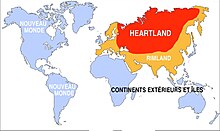This article needs additional citations for verification. (February 2017) |

The Rimland is a concept championed in the early 20th century by Nicholas John Spykman, professor of international relations at Yale University. To him, geopolitics is the planning of the security policy of a country in terms of its geographical factors. He described the maritime fringe of a country or continent; in particular the densely populated western, southern, and eastern edges of the Eurasian continent.
He criticized Mackinder for overrating the Heartland as being of immense strategic importance due to its vast size, central geographical location and supremacy of land power rather than sea power. He assumed that the Heartland will not be a potential hub of Europe, because:
- Western Russia was then an agrarian society
- Bases of industrialization were found to the west of the Ural mountains.
- This area is ringed to the north, east, south, and south-west by some of the greater obstacles to transportation (ice and freezing temperature, lowering mountains etc.).
- There has never really been a simple land power–sea power opposition.
Spykman thought that the Rimland, the strip of coastal land that encircles Eurasia, is more important than the central Asian zone (the so-called Heartland) for the control of the Eurasian continent. Spykman's vision is at the base of the "containment politics" put into effect by the United States in its relation/position to the Soviet Union during the post-World War II period.[citation needed]
Thus, 'Heartland' appeared to him to be less important in comparison to 'Rimland.'